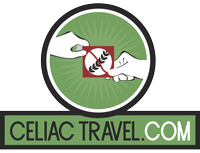Article provided by FlyBe.
Celiac or coeliac disease is an autoimmune disorder in the small intestine, often agitated by consuming gluten protein which is found in wheat, barley, oats and rye. Bread is the obvious food stuff for celiacs to avoid, but when eating out, it is often difficult to know what ingredients have gone into a product.
With more and more people suffering from celiac disease, major food outlets, supermarkets and many restaurants and fast food chains are now offering gluten free products as alternatives. However, eating out in restaurants, cafes or even at friends` homes can cause problems for the celiac.
Plan for delays when travelling by plane
Travelling by plane is one such situation where the celiac has to be extra vigilant. Flight delays can mean a long wait in an airport, surrounded by fast food outlets where the celiac wishes to purchase a meal. If you suffer from celiac disease, it is up to you to make your condition clear to the chef, but it is also your responsibility to explain that any contact that your food has with even the odd breadcrumb could trigger a reaction.
Therefore, suggest that the person serving the food uses a clean implement to serve your food, and ask for the food to be prepared preferably where you can see it. Ensure that if you buy a burger from a cafe, the grill used to cook it is not the same one used to grill the bread buns. An alternative method of cooking your food would be to ask for your food to be covered and microwaved instead. Always carry a gluten free restaurant card to show to the chef. This will give you peace of mind when eating out. Where possible, ask to speak to the manager and explain your situation to her or him.
Booking gluten free food on flights
When booking a flight with meal, many airlines offer the choice of gluten-free food. However, as the food company supplying in-flight meals has to prepare thousands of meals in the same factory, it is possible that some contamination could occur. Therefore, an option is to ask the airline to order some whole uncut fruit and vegetables for you, thus reducing the risk of contamination.
Follow up your request with a phone call to the airline to double check that they understand your needs. Prepare a small container of food to take inside your cabin bag. Security may ask you to throw it away, although if you explain about your gluten allergy you may be allowed to keep it. This is particularly important on a long-haul flight, as the alternative may be to go without food for many hours.
When boarding the plane, inform the stewards of your special request and check that they know where you will be seated. Emphasise the importance of avoiding cross contamination. This can go unnoticed at the food preparation stage without you even knowing about it. It can also occur as food is served, particularly in a compact space such as a flight cabin.
Gluten free airlines
Many of the big airline companies offer gluten-free meals to their passengers. These include Aer Lingus, Emirates, KLM, Lufthansa, Singapore Airlines, Thomas Cook Airlines, Thomson Airways and Virgin Atlantic. Most of these companies require at least 3 days notice, so it is best to double check that your request has been acknowledged before you fly, with the check out desk and flight attendants. If all else fails, and you are not sure whether to trust the food that is served to you, the food that you have brought with you will see you through the flight.
————————-
Although this article was prepared by FlyBe, they have not made it clear whether they offer gluten free food on their flights, so please check before flying with them the same as you would for any other airline.
As always, gluten free travel is made much easier and safer with one (or more) of our free gluten free restaurant cards.
